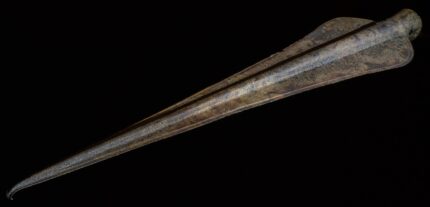A rare spearhead complete with surviving traces of its wooden shaft from the Late Bronze Age has been discovered on the Channel Island of Jersey. It dates to around the 11th century B.C. and is the largest and most complete spearhead ever found on the Channel Islands.
Metal detectorist Jay Cornick found the spearhead on Gorey beach last summer and had no idea it was so ancient. He thought it might be related to Mont Orgueil (aka Gorey Castle) which looms over the beach and originally dates back to the 13th century. He reported it to Jersey’s Finds Officer and Jersey Heritage experts examined and conserved it.
Spearheads from this period have been discovered before on the island, almost always in hoards, but they are usually broken into pieces or very heavily worn and are also much, much shorter. Comparing the length of other Bronze Age spearheads found on Jersey to this one is like comparing a Great Dane to a Chihuahua. Also remarkable was its exceptional condition. It was so pristine that conservators really only had to clean it.
It was during the cleaning process that the remnant of wood inside the shaft was found. Conservators were able to remove it and send it to the York Archaeological Trust for radiocarbon dating. YAT identified the wood as field maple, a type commonly used to make tools during this period, dating to between 1207 B.C. and 1004 B.C. Metal was extremely valuable and hard to come by in Bronze Age Britain. Most tools were still wood or stone, which is why spearheads from the period are generally much smaller. This was a precious treasure, not a utilitarian object. Archaeologists suspect it was deposited for ritual or ceremonial purposes shortly after it was made.
The spearhead is now on display at the Jersey Museum & Art Gallery.


Curious to know it’s length and how it compares to others, besides being much larger. There’s no figures given or any reference in the photos.???
Curious to know it’s length and how it compares to others, besides being much larger. There’s no figures given or any reference in the photos.???
The decorative line cast or inscribed into the spearhead near the edge would also indicate its ceremonial use since any sharpening of the edge would destroy the decorative line.
The way the tip of the point is curled makes one wonder if it was used in a ceremony to strike another object before being buried.
Nobody knows exactly where the tin comes from! At least Herodotus was highly skeptical, and obviously he did not make it to Jersey or any other channel island, unlike Pytheas of Massalia (310–306 BC) and his lost work ‘Περὶ τοῦ ᾿Ωκεανοῦ’/ Overseas. The “Cassiterides” –here spelled with C instead of a Kappa– may have been a trading floor:
———
3.115:”…[in addition to Asia and Africa] of the extremities of Europe towards the West I am unable to speak with certainty, for neither do I accept the tale that there is a river called in Barbarian tongue Eridanos, flowing into the sea which lies towards the North Wind, whence it is said that amber comes, nor do I know of the real existence of ‘Tin Islands’ from which tin comes to us [οὔτε νήσους οἶδα Κασσιτερίδας ἐούσας, ἐκ τῶν ὁ κασσίτερος ἡμῖν φοιτᾷ]…”
———
The Greek Hesiod around 700BC mentions the “Eridanos” river –which might be the ‘Albis’/Elbe– in his Theogony. The (Westphalian) Hellweg is a flood-free connection dating back more than 5,000 years to early Neolithic times from the Rhine at Alt-Homberg via Duisburg, Essen, Dortmund, Unna, Werl, Soest, Erwitte, Geseke, Salzkotten, Paderborn to Corvey.
East of the Hellweg, the Danzig area is reached over destinations mentioned by Ptolemy like Susudata, Colancorum, Viritium and Scurgum, while if you follow the Hellweg westwards, you pretty much end up in Jersey (notably, I am not at all alluding that Jesey should be any of the Cassiterides).
:hattip:
—
PS: Have a look at the 23cm ‘Saufeder’ boar hunting spear from: metmuseum.org/art/collection/search/26727
A spear that one would actually throw might be in the area of +12cm, while this bronze spear might be 25cm, or probably not longer than 30cm, i.e. slightly larger than the boar spear. The line cast might be decorative or a residue from the casting process. The latter case would indicate a brand new weapon cast, but already with the ‘field maple’ inserted.
Indeed, that curled tip might be ‘decorative’. No idea, what it would take to achieve a similar tip accidentally :confused:
Maybe, if somebody could bring over a test boar…
Since it was common to bend swords before ritually depositing them, bending the tip of the spear may have been the best they could do.
Or it was a very big boar, and managed to evade those attempting to invite him for lunch. At least, not until he had made sure that no boar would be subject to that spear again.